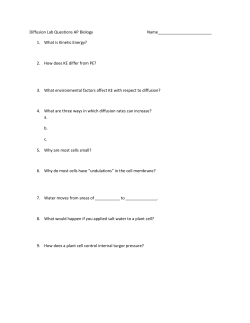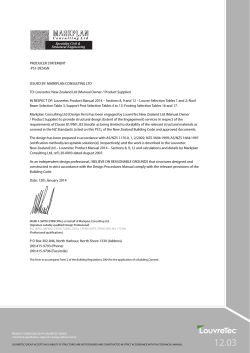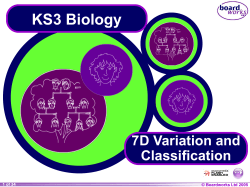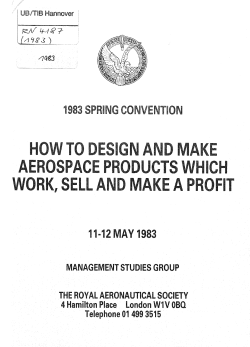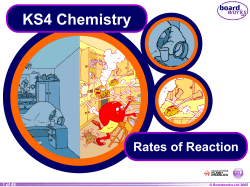
Diffusion 1 of 27 © Boardworks Ltd 2011
Diffusion 1 of 27 © Boardworks Ltd 2011 2 of 27 © Boardworks Ltd 2011 What is diffusion? 3 of 27 © Boardworks Ltd 2011 Diffusion and concentration Why can the student smell the sock from a distance? The sock can be smelt because sweat and other molecules are moving away from it and spreading out in the air. This is called diffusion. Where is the smell strongest? The smell is strongest at the sock. The smell becomes weaker further away from the sock. 4 of 27 © Boardworks Ltd 2011 Moving molecules In which states are molecules able to diffuse? solid (e.g. ice) liquid (e.g. water) gas (e.g. steam) Molecules in liquids and gases are constantly moving and bumping into each other. This means that they tend to spread out. By contrast, solids cannot diffuse. 5 of 27 © Boardworks Ltd 2011 Diffusion in action: one gas 6 of 27 © Boardworks Ltd 2011 Diffusion in action: two gases 7 of 27 © Boardworks Ltd 2011 Changing concentrations During diffusion molecules move from an area of high concentration to an area of low concentration. They are said to move down a concentration gradient. Diffusion is a passive process which means that no energy is needed. high low concentration concentration Molecules diffuse until they are evenly spaced apart and equilibrium is reached. The rate of diffusion depends on several factors, such as the distance the particles have to travel and the difference in concentration. 8 of 27 © Boardworks Ltd 2011 Diffusion: true or false? 9 of 27 © Boardworks Ltd 2011 10 of 27 © Boardworks Ltd 2011 Why is diffusion important to life? Diffusion is the main way in which substances move over short distances in organisms. What substances need to move? Oxygen, food and waste products are some of the substances that move by diffusion. In animals, how do these vital substances get to where they are needed? The substances are transported in the bloodstream, from where they can diffuse in and out of cells. 11 of 27 © Boardworks Ltd 2011 Diffusion and breathing Breathing involves the exchange of gases in the lungs; a process that occurs by diffusion. What happens when you breathe in? Oxygen in inhaled air diffuses through the lungs and into the bloodstream. The oxygen is then transported throughout the body. Carbon dioxide is the waste gas produced by respiration. Carbon dioxide diffuses from body tissues into the bloodstream and is exhaled via the lungs. Where does gas exchange take place in the lungs? 12 of 27 © Boardworks Ltd 2011 Structures of the respiratory system 13 of 27 © Boardworks Ltd 2011 Cross-section through an alveolus Alveoli are the tiny air sacs at the end of the bronchioles, in which gas exchange occurs. deoxygenated blood (from body tissues) air in/out alveolus capillary red blood cell 14 of 27 oxygenated blood (to body tissues) © Boardworks Ltd 2011 How are alveoli adapted? Alveoli have several adaptations that help to make gas exchange very efficient: They are very thin – only one cell thick. They are covered by a network of fine capillaries, enabling gases to pass almost directly between the lungs and bloodstream. They are moist, encouraging gas molecules to easily dissolve. They have a large combined surface area, allowing large amounts of gases to be exchanged with each breath. 15 of 27 © Boardworks Ltd 2011 What happens in the alveoli? 16 of 27 © Boardworks Ltd 2011 Diffusion and digestion Carbohydrates, proteins and fats are made up of large molecules that cannot be readily absorbed by the body. Digestion breaks down large food molecules into smaller molecules such as glucose, amino acids and fatty acids that can be easily absorbed. In which part of the digestive system is most food absorbed? 17 of 27 © Boardworks Ltd 2011 Diffusion and the small intestine 18 of 27 © Boardworks Ltd 2011 Diffusion and the placenta The placenta is an organ that develops in the uterus of female mammals during pregnancy. The umbilical cord connects the placenta to the fetus. The placenta enables nutrients and oxygen to pass from the mother to the fetus by diffusion, and waste substances to diffuse from the fetus back to the mother. The placenta can filter out certain molecules and bacteria, but is unable to stop many harmful substances such as alcohol, chemicals and some types of virus from reaching the fetus. 19 of 27 © Boardworks Ltd 2011 Diffusion and the placenta How does the placenta work? umbilical cord umbilical artery umbilical vein 20 of 27 blood to mother low in O2/nutrients, high in CO2/waste placental villi increase surface area for diffusion blood from mother high in O2/nutrients, low in CO2/waste © Boardworks Ltd 2011 Diffusion and nerves impulses A synapse is a junction between two neurones across which electrical signals must pass. synaptic cleft neurotransmitter neurotransmitter receptor nerve impulse Neurotransmitter molecules diffuse from vesicles towards the neurotransmitter receptors, moving from an area of high concentration to low concentration. 21 of 27 © Boardworks Ltd 2011 Diffusion in plants Plants use carbon dioxide and produce oxygen during photosynthesis. These gases move in and out of the plant by diffusion. When the concentration of carbon dioxide inside the plant is low, it will diffuse in from the air, through pores in the leaves into the plant cells. If the concentration of oxygen is high inside the plant, it will diffuse from the plant cells through the pores and into the air. 22 of 27 © Boardworks Ltd 2011 23 of 27 © Boardworks Ltd 2011 Glossary 24 of 27 © Boardworks Ltd 2011 Anagrams 25 of 27 © Boardworks Ltd 2011 Which process? 26 of 27 © Boardworks Ltd 2011 Multiple-choice quiz 27 of 27 © Boardworks Ltd 2011
© Copyright 2025




